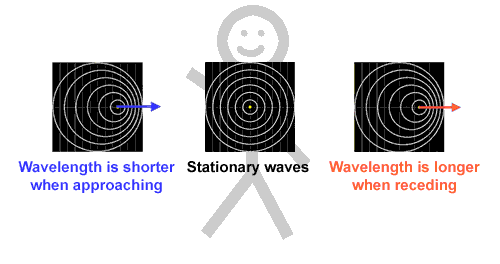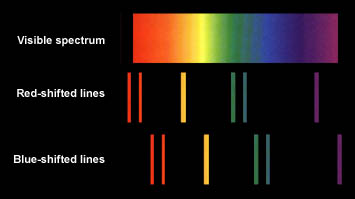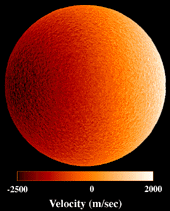AstroCappella: Doppler Shifting
Doppler Shifting on Earth
When you see a cop by the roadside writing somebody a speeding ticket, or hear the clamor of a fire truck going by, you're probably not sparing much thought for the expansion of the universe, or even the rotation of the Galaxy. But in fact, all these things are connected. The policeman using his or her radar or laser speed gun to enforce a traffic law is using the same physical principle that scientists use to study the rotation and motion of stars, the distance to the edge of the Milky Way galaxy, and even learn important things about our entire universe. This physical principle is called the DOPPLER SHIFT.

When the fire truck passes, the sound of its siren changes. The sound waves emitted by the approaching fire truck are pushed closer together by its motion, so the notes seem to have a higher frequency than they'd have if you and the fire truck were both parked. In the same way, the sound waves from a receding fire truck are appear to have a lower frequency. The cop waiting by the roadside with his speed gun uses the same physical effect; he bounces a radar wave off your car and measures the frequency of the reflected wave. The frequency will be higher the faster you're going. Better not be going too fast, because the policeman can measure your speed to a fraction of a mile per hour using this method - probably more accurately than your speedometer, in fact.
Johann Christian Doppler (1803-1853) first demonstrated the effect using sound waves. But we see a similar effect with light waves. On Earth the effect is so tiny that we normally don't notice it. But when we study the stars, we can get a lot of mileage out of the Doppler Effect.
From Earth to Moon
We can bounce radar waves off the Moon and the nearby planets in the same way as we can bounce them off a car. The development of radar during World War II allowed scientists to accurately determine the distance to the Moon by measuring the time delay required for a radio signal to return to the Earth. Nowadays, using laser ranging, we can measure distances to the Moon to within an error of 3 cm, and make topographic profiles of lunar craters and mountains without even going there.At 240,000 miles, the Moon is close enough for us to make active measurements. But for most of astronomy the situation is different; we can't experiment with a star (yet), or bounce radar off another galaxy (because the power needed would be too great and the time it would take for the wave to bounce back is too long), so scientists will make passive measurements from afar, try to interpret what they see in the sky, and make their theories. Further observations will then prove or disprove this theory. Sometimes a theory may lead scientists to perform observations they wouldn't otherwise think of. One example: Einstein's Theory of Relativity predicts that light will bend when passing a sufficiently massive object, and astronomer Arthur Eddington proved this during a solar eclipse in 1919, by measuring the change in the apparent position of stars whose light passed close to the edge of the Sun.
But let's get back to the DOPPLER EFFECT.
Redshifts, Blueshifts
 Stars emit light. Using a prism or a diffraction grating, we can spread
this light out into a spectrum. If we look at the spectrum of the Sun or
any other star, we see not only the rainbow of colors from red, orange and
yellow through to violet, but also a distinctive pattern of dark lines. At
certain wavelengths, light will be ABSORBED by chemical elements like
hydrogen, helium, calcium, and iron. These wavelengths are based on atomic
physics and can be measured extremely accurately in a laboratory on Earth.
Stars emit light. Using a prism or a diffraction grating, we can spread
this light out into a spectrum. If we look at the spectrum of the Sun or
any other star, we see not only the rainbow of colors from red, orange and
yellow through to violet, but also a distinctive pattern of dark lines. At
certain wavelengths, light will be ABSORBED by chemical elements like
hydrogen, helium, calcium, and iron. These wavelengths are based on atomic
physics and can be measured extremely accurately in a laboratory on Earth.
If a star is moving towards us, the whole pattern of the spectrum gets shifted to shorter wavelengths, i.e. towards the blue end of the spectrum. This is a BLUESHIFT, and we can measure it very accurately by comparing the apparent wavelengths of the spectral lines with the known laboratory wavelengths. If the star is receding, the pattern moves to longer, redder wavelengths, and this is a REDSHIFT. "Blueshifts come, and redshifts go, and that's pretty much everything you need to know."
Here's the equation:
v = c x (wavelength shift) / (wavelength)
where v is the relative velocity (speed) of the star, c is the velocity of light, and {wavelength} the known wavelength of the line as measured in the laboratory. We can use this equation until the relative speed becomes a significant fraction of the speed of light -- and then it's back to Einstein's Theory of Relativity, for a more detailed formula.
Extremely careful measurements of nearby stars can determine their relative speeds with a precision as small as 10 meters per second. Analyzing a large number of nearby stars shows that our Sun and its neighbors orbit the distant center of our Milky Way galaxy with a velocity of 250 km/sec. We're about 26,000 light years from the center of the Galaxy, and so it'll take 220 million years for us to complete an orbit. We can also tell that the stars nearer the center of the Galaxy rotate faster, so we're being 'passed' by those stars nearer the center, and 'overtaking' those stars that orbit further from the center of the Galaxy; this is the DIFFERENTIAL ROTATION of the Galaxy.
But that's not all
There are many more things we can learn using the Doppler Shift, and here is a summary of just a few:
- We can measure the masses of binary stars, by detecting the velocity
changes as they orbit around their common center of gravity, and combining
these velocities with the period of the orbit.
- In the same way, we can look for evidence of massive planets in orbit
around other stars, by searching for the small velocity changes in the
central stars caused by their unseen planetary companions. This is not an
easy thing to do. For example, the Sun and Jupiter move around their
common center of gravity with a period of 11.86 years, and the variation
of the Sun's motion as seen from an observer outside the Solar System has
an amplitude of 12.5 meters per second as a result. Scientists at NASA and
many universities are conducting long-term projects to monitor stars for
low-amplitude periodic variations in velocity that may reveal such planets
to us.
- Certain types of stars known as CEPHEID VARIABLES have atmospheres
that swell and shrink periodically. Using the Doppler technique, we can
tell that such a star's surface may be moving at speeds up to 50 km/sec.
As the period of the pulsation is related to the average brightness of the
star, we can tell roughly how far away the star is by combining its
apparent brightness with its pulsation period. So the Doppler Effect can
help us determine distances as well as speeds!
Read more about how Edwin Hubble used Cepheid variables to determine that
"spiral nebulae" were really other galaxies.

- We can detect the rotation of the Sun easily enough by following the
positions of SUNSPOTS, but the spectrum of the light from various regions
of the Sun also shows this rotation. The equator at the Sun's east limb is
approaching us at 2 km/sec, and the west limb is retreating from us at the
same speed. The same thing happens in other stars. They're further away,
so we can't study each edge of the star in the same way. However, we can
see that the absorption lines are BROADENED, or smeared out, by the
rotation. Some stars have equatorial speeds of 400 km/sec; if they spun
any faster, they would break up!
- When we look at the spectra of other galaxies and map their
velocities, we find that on average, all galaxies are speeding away from
each other, with very high redshifts. (There are exceptions, where
galaxies are close enough to be drawn together by their gravities.) The
Doppler Shift tells us that the universe as a whole is expanding. What's
more, galaxies at greater distances ('higher redshifts') are speeding away
more quickly -- just as you'd expect in the aftermath of a giant
explosion: the Big Bang.
And finally, it now looks as if the expansion of the universe is accelerating.
Read more about the Hubble constant, the expansion of the universe, and dark energy
- And so on, out to the edges of the Universe ... 'Behind' the stars
and galaxies and clusters of galaxies, scientists can detect the COSMIC
BACKGROUND RADIATION left over after the Big Bang. This radiation has a
temperature just three degrees above Absolute Zero -- redshifted into the
radio portion of the electromagnetic spectrum. Read more about the cosmic microwave
background.
